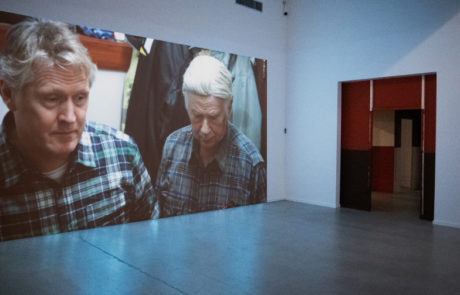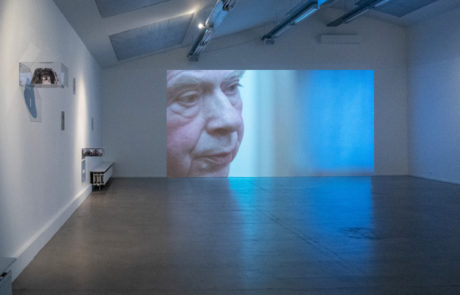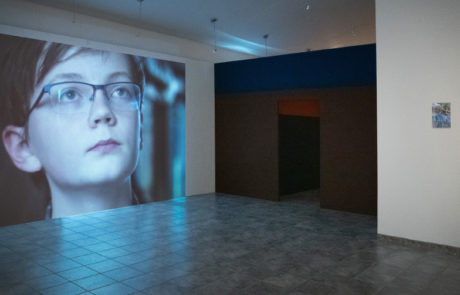
SUBJECTIVE SPACES
Ólafur Sveinn Gíslason
January 12 – March 31, 2019
Margrét Elísabet Ólafsdóttir
TIME OF MEMORY – SPACE OF ACTION
Ólafur Gíslason’s works raise questions about the space of art and works of art, and the role of the artist and others in creating that space. Ólafur’s perspective is based in his conviction that the creation of a work of art is not only the role of the artist; and hence he has adopted a certain working process which involves active participation by others. His works come into existence at a specific site; they are shaped by his dialogues with individuals and groups connected to the place; and ultimately, they address the place or space from which they emerge. The spaces are simultaneously objective and subjective, and come together in the works. Ólafur may be said to take a “mould” of subjective spaces, which he then transfers into objective spaces – whether in a home, a gallery or a public space. At the same time his works consider the discrete spaces – or crannies – of society, and the individuals and groups that exist within them.
Ólafur has applied a number of different techniques to create works in collaboration with others; over time, interviews have attained a certain weight in that collaboration. He has thus moved away from making pieces on site with the direct participation of the public, and instead he collaborates closely with individuals and groups, with whom he talks. He has displayed interviews in text form in Shallow Roots (2001) and Dreaming in Hannover (2002), and also as audio works in Global Marriages (2003) og gemeinschaften (2004). Since that time, film as a medium has taken on a bigger role in the development and presentation. The interviews are not directly recorded and then screened; they are rewritten as a script which is performed and filmed using actors and the original interviewees. Ólafur has shown audio and film works as part of installations, referencing the methods he uses to change the exhibition space, e.g. by building a stage or partitions. The installations include works of other kinds, such as drawings, watercolours and models. The outcome is a work grounded in spatial thinking, manifested in the interaction between the exhibition space, the placing of objects in the space, the inner space of audio and film, and the space for action or narrative.
Participation space
During his thirty-year career as an artist, Ólafur Gíslason has used various approaches to create a situation for collaboration with individuals and groups. His oldest participatory work is Picture Order (1991). In Medium St. Pauli (1995) he worked with bar owners in the eponymous district of Hamburg to encourage customers to draw and write. In Modelling Out at Sea (1997) he moored a barge off the shore in Eckernförde, a town on the Baltic coast of Germany. On it were lumps of clay, which the bathers on the beach could mould into figures, that were then displayed in a local art gallery. In this work, as in Medium St. Pauli, the artist temporarily established conditions for creativity in a predetermined space – in the latter case a barge moored off- shore, and in the former pinboards and drawing equipment provided in nine bars in Hamburg’s red-light district.
The earlier work lasted several months, and some of the contributions were ultimately displayed to the public.
Unlike these two projects, the wooden cabin in Media Thule (1994) is still standing, near the town of Myklebostad in Tjeldsund, north Norway. Visitors can sit there with a view of the sea, and allow their minds to rove, using brushes and watercolours on paper. A local volunteer group keeps the project going.
In these works, chance plays a clear role; participants are given absolute freedom of action within a predefined framework. Over time Ólafur’s methods have evolved towards closer collaboration with participants, while film/video plays a major role in presentation.
From interview to film
Ólafur first used video in an installation in his work Golden Bamboo (2002), based on an interview with a Vietnamese immigrant in the former East Germany. The video shows a palm tree being moved from a Vietnamese restaurant in Dresden to the exhibition site in the same city. The time- specific visual medium was used to portray the transportation of the tree, and at the same time it served as a metaphor for the journey of the restaurant owner from Vietnam to East Germany, and his ultimate adaptation to new conditions in reunified Germany. After that Ólafur started to develop a new methodology, in which he films actors delivering text. Theater Real (2004) is a key work in that process, based on interviews with seven shopkeepers on Wandsbeker Chaussee, a street in Eilbek, Hamburg. The interviews were initially recorded, then staged for filming in the stores. The film was screened as part of a stage-installation in a retail space between the stores involved in the project. Visitors were invited onto the stage, and backstage they could watch a window that faced out into the street, while the film was projected onto a screen above the window. The film and the live street scene outside combined into a continuous image of space/time thinking: on the one hand the street scene, and on the other the film of the shopkeepers’ thoughts about the community of the street. Similar ideas and presentation are seen in Strukturwandel (2005) and Fish Drama (2006), about fisheries and international trade in fish products, in which Ólafur juxtaposes different activity spaces.
Picture space
Together parallel (2008) addresses a comparable idea, though differently presented. Ólafur made the work when he was district artist in Veddel, Hamburg1, which has a large immigrant population. Preparations for the work took some months, in collaboration with the residents. The work itself was shown as an installation, with two films projected onto opposing walls. The exhibition space was divided by large hangings made of men’s and women’s shirts. Chairs were arranged along the hangings so that both films could be watched at the same time, alternating between them. The hangings were sewn by a woman from Albania, who was paid for her needlework. She was filmed as she worked, but for religious reasons she wished to remain unidentifiable. The shirts were also used in various scenes of the film. An exception from Ólafur’s film screenings in specially-arranged spaces is his film Prison Guards (2017), which is conceived for screening in a cinema rather than a gallery space. It was premiered in Reykjavík’s art-house cinema Bíó Paradís.
It can prove hard to define the film Prison Guards in conven- tional terms, as it is neither a conventional documentary, nor a conventional drama. There are no fictional characters, only real-life prison guards, though they are not identified by name or as individuals. The film’s progress is not driven by a story line, nor by individual personal narratives. Two prison guards and two professional actors act in the film, presenting a script based on the prison guards’ own accounts of their work. The juxtaposition of interview subjects with actors underlines the division between documentary and staging.
The location contributes to blurring that distinction, as the film is shot in the prison guards’ workspace in the old prison on Skólavörðustígur in downtown Reykjavík. The audience sees the prison guards at their work in cramped conditions, and hears them describe their work, their relationship with the prisoners, and their sense of attitudes in society outside to their work and workplace. Through the prison guards’ monologues, in the real-life space of the prison between freedom and confinement, a subjective space is created arising from descriptions of actions, experiences and mental states. The screening of the film in a cinema also contributes to the sense of constraint and lack of space.
Installation-film
Subjective Spaces, shown by Ólafur Gíslason at the LÁ Art Museum, is a direct continuation of his prior works. Many different elements are combined in the work, which extends through the museum’s exhibition spaces and part of the foyer. The material used in the exhibition, and individual elements of it, have their origins in a relationship of many years between Ólafur and a person who lives on a farm in south Iceland, which is no longer farmed in the traditional manner. The farmer works elsewhere, but keeps a few sheep on the farm. He has also cultivated woodland on the property, and experimented with potato-growing. The work is largely based upon Ólafur’s interviews with the farmer, who in this work is the only interview subject. The artist has divided the interviews up by theme into a number of short films. As in together parallel, the films are shown together: in this case six films are screened at four places in the museum: two are shown singly, while in two spaces they are shown in pairs, using two projectors in tandem. The editing of the films takes account of their location in the spaces, with the objective of drawing the attention of the observer alternately to the projected films.
In a cinema the audience sit still in their seats during the show. The reverse is true where a film is part of an installation in which other objects can be examined. In an installation there is no guarantee of comfortable seats, nor of a defined programme with a beginning and an end. The beginning is wherever the viewer comes in, and the end is wherever the viewer started to watch. Between the two is the progress of the film; and the viewer is free to decide whether to stay, and for how long. French scholar Raymond Bellour has used the term installation-film for such works, which are an established element in contemporary art. Installation refers to the setting in which the film is shown, and the way that it informs the perception and reception of the film. The screening of the installation-film in the space is not subject to any rules, other than those determined by the artist.
Time-space
The scripts of the films in Subjective Spaces are based on interviews with one individual, while the script is acted by five people: one professional actor (a middle-aged man), three local people (a young lad, a young man and a woman in her prime), as well as the interview subject himself. In each film we see two or three of them together: the farmer, the lad and the actor; the lad, the woman and the farmer; the farmer, the young man and the actor; and so on. All are similarly dressed, in a chequered shirt, sometimes with the addition of a woollen sweater, jacket or coat. They wear corduroy trousers or jeans, rubber boots, and a hat. The clothing and the setting have a timeless ambiance. In each film the characters talk about a certain subject, recalling and recounting, without directly conversing with each other. They seem to be talking to themselves, not each other, but what they say is always heard by another. The person who speaks is one character – the character of the farmer. This method informs the presentation of text and video in a time dimension split into two or three, in which the same individual, or his alter egos, are seen simultaneously, providing insight into the different aspects of his personality at various periods of his life. The presence of the farmer in the frame, together with actors representing him, establishes an ambiance of intimacy and sincerity – and at the same time a certain distance between the text and the interviewee.
Ólafur’s selection of actors in each film is informed by the theme of each, and whether it consists of a narrative about way of life, recollection of events or childhood memories, relationship with parents, livestock or soil. Subjects include such traditionally feminine interests as flower-growing and knitting, as well as carpentry, afforestation, sheep and cookery. The themes have manifold links with time, according to whether they are memories, descriptions of interests, or the farmer’s life today.
Film is a time-specific medium, but it is also space-specific, providing an opportunity to show and develop what Bellour calls time-space. The objective space of the film is manifested as the selection of locations for certain elements and shots – whether in the woods, inside the barn, in the storage shed, on the stairs, in the living room or in the food-smoking shack. These places are parts of the farmhouse and its surroundings, and the farmland around it. They demarcate the farmer’s home territory, and the space that encompasses his daily life. The spaces are used as a context and frame for specific themes. The subject of discourse itself has the role of delineating and forming subjective spaces of memory and experience relating to the origins of interests, objects and buildings, and attitudes to daily tasks. This material gives rise to images of a man which open a gateway into an entire semiotic world. Subjective Spaces simultaneously presents an image of the story of an individual and the story of a community – which is also a story of time, eras and a place.
Curator:
Margrét Elísabet Ólafsdóttir is an Assistant Professor at the University of Akureyri in north Iceland and a freelance scholar, critic, curator and project manager. She studied at the Sorbonne-Panthéon University in Paris, France, for her Diploma in Cultural and Communication Studies. She followed this with further studies in aesthetics, completing her PhD from the Sorbonne in 2013. Margrét’s research has focussed on electronic and digital art in Iceland, while she has recently turned her attention to modern Icelandic art.
About the artist:
Ólafur Sveinn Gíslason graduated from the Icelandic College of Arts and Crafts in 1983 and the Hochschule für bildende Künste in Hamburg in 1988. After graduation he lived in Germany, working on art projects which were shown in galleries, art museums and public spaces in Europe and elsewhere; he also exhibited his work regularly in Iceland. In 2007 Ólafur returned to Iceland when he was appointed professor at the Fine Arts department of the Iceland University of the Arts. Since 2015 he has had a studio at Þúfugarðar in the Flói area of south Iceland. What characterizes Ólafur‘s art is the social aspect, where the relationship between the artist and society, the participants’ activity in creating the works, and the observers’ circumstances, are important factors. In that sense his art is connected to „relational aesthetics“, where the central discourse is on the relationship between individuals in a given context. He pursues questions where personal destiny and general social questions intersect. In his work Ólafur has addressed children‘s anxiety (Aus dem Kinderzimmer, KX Kampnagel, Hamburg 2000), the conditions of immigrants (Träumen in Hannover, Sprengel Museum, Hannover 2002), the identity of young Icelanders (Identity Check, ASÍ Art Museum, Reykjavik 2010) and the unusual working conditions of prison guards (Prison Guards (premiered at Bíó Paradís cinema in Reykjavík January 2017). The nucleus of each work is always the specific experience/ story of the participants, entailing a panoply of wider allusions.
Works by Ólafur are in public and private collections in Iceland and abroad.




